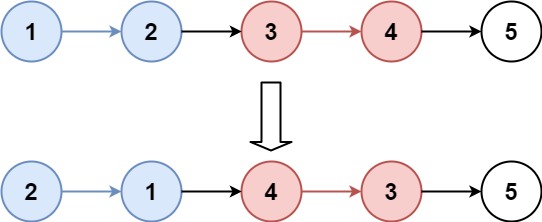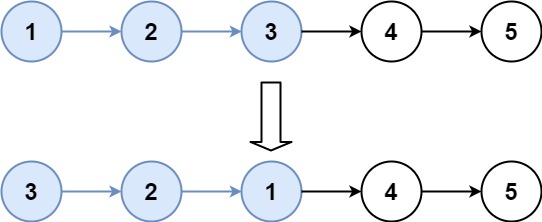本文目录
题目描述
给你链表的头节点 head ,每 k 个节点一组进行翻转,请你返回修改后的链表。
k 是一个正整数,它的值小于或等于链表的长度。如果节点总数不是 k 的整数倍,那么请将最后剩余的节点保持原有顺序。
你不能只是单纯的改变节点内部的值,而是需要实际进行节点交换。
示例 1:

输入:head = [1,2,3,4,5], k = 2 输出:[2,1,4,3,5]
示例 2:

输入:head = [1,2,3,4,5], k = 3 输出:[3,2,1,4,5]
个人C++解答
/**
* Definition for singly-linked list.
* struct ListNode {
* int val;
* ListNode *next;
* ListNode() : val(0), next(nullptr) {}
* ListNode(int x) : val(x), next(nullptr) {}
* ListNode(int x, ListNode *next) : val(x), next(next) {}
* };
*/
class Solution {
public:
ListNode* reverseKGroup(ListNode* head, int k) {
ListNode* result = new ListNode();
ListNode* p = head;
ListNode* q = result;
int ListLen = 0, count = 0;
while (p) {
ListLen++;
p = p->next;
}
p = head;
stack<int> stk;
while (p) {
int time = k;
while (time--) {
stk.push(p->val);
p = p->next;
}
time = k;
while (time--) {
q->next = new ListNode(stk.top());
q = q->next;
stk.pop();
count++;
}
if (ListLen - count < k)
break;
}
q->next = p;
return result->next;
}
};
官方题解
class Solution {
public:
// 翻转一个子链表,并且返回新的头与尾
pair<ListNode*, ListNode*> myReverse(ListNode* head, ListNode* tail) {
ListNode* prev = tail->next;
ListNode* p = head;
while (prev != tail) {
ListNode* nex = p->next;
p->next = prev;
prev = p;
p = nex;
}
return {tail, head};
}
ListNode* reverseKGroup(ListNode* head, int k) {
ListNode* hair = new ListNode(0);
hair->next = head;
ListNode* pre = hair;
while (head) {
ListNode* tail = pre;
// 查看剩余部分长度是否大于等于 k
for (int i = 0; i < k; ++i) {
tail = tail->next;
if (!tail) {
return hair->next;
}
}
ListNode* nex = tail->next;
// 这里是 C++17 的写法,也可以写成
// pair<ListNode*, ListNode*> result = myReverse(head, tail);
// head = result.first;
// tail = result.second;
tie(head, tail) = myReverse(head, tail);
// 把子链表重新接回原链表
pre->next = head;
tail->next = nex;
pre = tail;
head = tail->next;
}
return hair->next;
}
};
作者:力扣官方题解
链接:https://leetcode.cn/problems/reverse-nodes-in-k-group/solutions/248591/k-ge-yi-zu-fan-zhuan-lian-biao-by-leetcode-solutio/
来源:力扣(LeetCode)
著作权归作者所有。商业转载请联系作者获得授权,非商业转载请注明出处。

